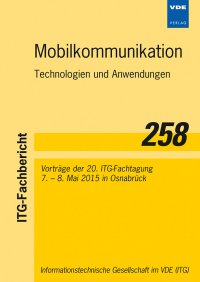A Flexible Spectrum Management Solution
Conference: Mobilkommunikation - 20. ITG-Fachtagung Mobilkommunikation
05/07/2015 - 05/08/2015 at Osnabrück, Deutschland
Proceedings: Mobilkommunikation
Pages: 5Language: englishTyp: PDF
Personal VDE Members are entitled to a 10% discount on this title
Authors:
Karrenbauer, Michael; Schneider, Joerg; Crippa, Marcos Rates; Schotten, Hans D. (Chair for Wireless Communications and Navigation, University of Kaiserslautern, Germany)
Abstract:
Today, mobile devices have become more and more powerful and offer a high diversity of internet-based applications for users. As a consequence, we need wireless network systems which are able to cover large areas with high datarates. Systems like LTE enable high data-rates (100 MBit/s and above) combined with a low latency. Despite of all these new transmission technologies a major bottleneck is caused by the available spectrum. Obviously, to enable new spectrum ranges is a theoretical approach and illusory because of the regulatory authority and the physical characteristics. New approaches seem to deal with so called spectrum sharing techniques for assigning defined spectrum to different wireless systems. They try to enable the usage of so called ”White and Gray Spaces” and allow usage by secondary services. Cognitive Radio (CR) was one of the first concepts to address this issue. The key function of every Cognitive Radio device is spectrum sensing to assure an interference-free transmission for the spectrum owner. In the meantime, additional solutions like Licensed Shared Access (LSA), Co-Primary Shared Access or License Assisted Access (LAA) have been developed. Depending on the frequency range (licensed or unlicensed), negotiation or sensing based approaches are used. In this paper we introduce a comprehensive spectrum management architecture which is able to deal with licensed as well as unlicensed spectrum ranges. Additionally this paper will show a low cost sensing solution consisting of low cost consumer hardware and embedded computers. We use a generic DVBT dongle as radio interface which allows us to obtain raw 8 bit I/Q-samples in a frequency range from 24 MHz to 1766 MHz. In order to achieve reliable measurements, we calibrate the frequency-dependency of the measured input power level using state of the art equipment. The Raspberry Π, a well known credit card-sized single-board computer, is used as the host for the DVB-T dongle. To analyze the cooperatively gathered spectrum information, every sensing node transmits its information to a Spectrum Management Unit using SpectrumML, a specially designed XML derivative. These entities will also be described in this paper.


